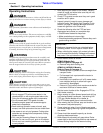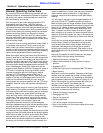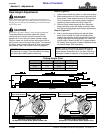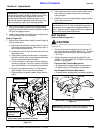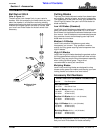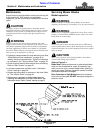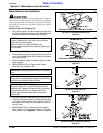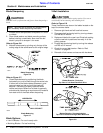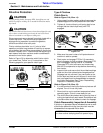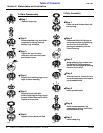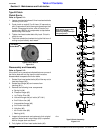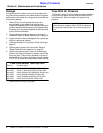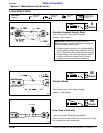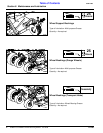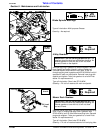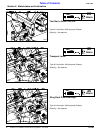
27
Section 5: Maintenance and Lubrication
11/14/08
AFM4214 and AFM4216 All-Flex Grooming Mowers 315-587M
Land Pride
Table of Contents
Driveline Protection
!
CAUTION
Engage parking brake, disengage PTO, shut off tractor, and
remove key before working on or around the driveline and/or
slip clutch.
!
CAUTION
Slip clutches that have been in use or have been slipped for only
two or three seconds during run-in may be too hot to touch.
Allow a hot clutch to cool before working on it.
Drive components are protected from shock loads with a
friction slip clutch. The clutch must be capable of
slippage during operation to protect the gearbox,
driveline and other drive train parts.
Friction clutches should be “run-in” prior to initial
operation and after long periods of inactivity to remove
any oxidation that may have accumulated on the friction
surfaces. Repeat “run-in” instructions at the beginning of
each season and when moisture and/or condensation
seizes the inner friction plates.
Refer to Figure 5-9 to determine which friction clutch
your mower has. Follow “run-in” instructions on the
following pages for your specific clutch type.
Clutch Types
Figure 5-9
Type A Clutch Type B Clutch
26619
Type A Clutches
Clutch Run-In
Refer to Figure 5-10 (View - A):
1. Using a pencil or other marker, scribe a line across the
exposed edges of the clutch plates and friction disks.
2. Tighten all 4 nuts uniformly until spring load is low
enough that the clutch slips freely with PTO
engaged.
Type C Clutch Run-In
Figure 5-10
3. Make sure the area is clear of all bystanders and
machine is safe to operate.
4. Start tractor and engage PTO for 2-3 seconds to
permit slippage of clutch surfaces. Disengage PTO,
then re-engage a second time for 2-3 seconds.
Disengage PTO, shut off tractor and remove key.
Wait for all components to stop before dismounting
from tractor.
5. Inspect clutch and ensure that the scribed markings
made on the clutch plates have changed position.
Slippage has not occurred if any two marks on the
friction disk and plate are still aligned. A clutch that
has not slipped must be disassembled to separate
the friction disk plates. See “Clutch Disassembly,
Inspection & Assembly” below.
Refer to Figure 5-10 (View - B):
6. If no two marks on the friction disk and plate are still
aligned, Turn all 4 nuts fully back.
7. Allow clutch to cool to ambient temperature before
operating again. Clutch is now ready for use.
8. The clutch should be checked during the first hour of
cutting and periodically each week. An additional set
of scribe marks can be added to check for slippage.
Clutch Disassembly, Inspection & Assembly
If clutch run-in procedure above indicates that one or more
of the friction disks did not slip, then the clutch must be
disassembled into separate friction disks.
23696
IMPORTANT: Before proceeding, secure clutch firmly
in a vise or other clamping device to prevent injury.



